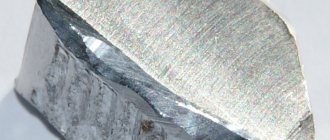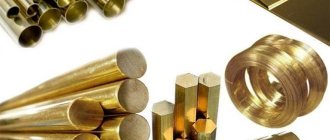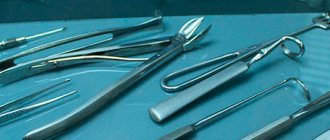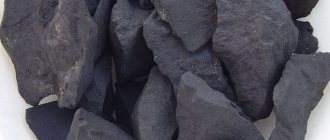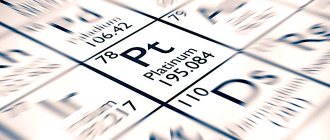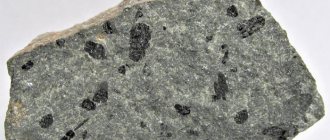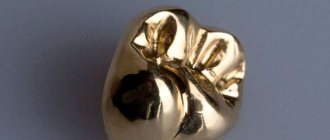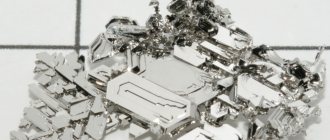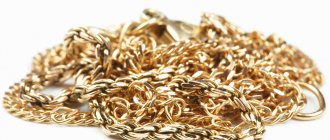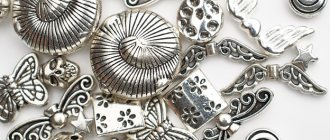How do ferrous metals differ from non-ferrous metals?
The above list is exhaustive for magnetic chemical elements (ferrous metals). If you make a combined list of non-ferrous and ferrous metals, it will include 78 chemical elements of the periodic table. At the same time, three types of ferrous metals, with the exception of iron, are also classified as non-ferrous according to certain characteristics. They are divided into types:
- heavy - copper, zinc, lead, tin, this also includes nickel;
- light – aluminum, titanium, magnesium and others (12 elements in total);
- refractory – manganese, tungsten, molybdenum, chromium and others (8 elements in total);
- noble, etc. (total 8 groups of non-ferrous metals).
It is much more difficult to list everything that relates to ferrous metals from a technical point of view. The total number of steel and cast iron grades includes several hundred product items. Moreover, some of them do not have magnetic properties, which allows, based on the combination of characteristics, to classify such alloys simultaneously as ferrous and non-ferrous metals.
Earth and star maternity hospital platinum
The main platinum deposits are located in the countries:
- Zimbabwe;
- USA;
- SOUTH AFRICA;
- China;
- Russia.
This is approximately 90% of the world reserve (according to some analysts). Others give the same 90% of platinum in nature to one South African deposits. Such strange “analytics” show that the bowels of the Earth have been explored approximately.
There are small deposits in South America, Canada and a number of countries.
We mine platinum
About interesting and important mining sites of the “queen of metals”. Platinum is found in placers and ultramafic bedrock.
World platinum production (tonnes per year) over recent decades.
The process of formation of the noble metal occurred not only on Earth. Some of the asteroids that fell to Earth were filled with platinum group metals.
South Africa
The largest “basket” on earth with platinum and platinum group metals is located in South Africa. This is the Bushveld complex. It looks like a saucer with a diameter of about 370 km. Horizons (reefs), lenses, and platinum veins stretch from the edges of the saucer to the center. Their thickness ranges from 1 to 90 meters; some reefs are mined by open-pit mining.
¾ of all platinum is mined here.
Russia
We had the richest placer deposits in the Urals. Since 1828, the country has minted platinum coins in denominations of 3, 6 and 12 rubles. For coins, native metal was used, not purified from accompanying metals. The coins were minted for only 17 years, then they began to be withdrawn from circulation.
After 100 years, the Ural deposits were depleted.
Currently, silver mining is carried out in Taimyr, on the Kola Peninsula, in the Khabarovsk and Krasnoyarsk territories.
Canada
In central Ontario, nickel and palladium are mined, and platinum is a “prize” for miners. By the way, most likely, the platinum group metals here are of extraterrestrial origin. Once upon a time a huge meteorite fell here.
The Lac des Iles mine in western Ontario uses open-pit mining for platinum group metals. Recently, an underground mine was opened here, where the content of noble platinoids is higher.
USA
There are only two mines here, both in Montana. However, the ore is rich, the content of platinum group metals is about 20 grams per ton of ore.
In 2015, a small asteroid (less than a kilometer in diameter) flew close to Earth. It differs from the mass of other celestial bodies in its “filling”. The core of the celestial stone, as astronomers have found, consists of platinum, gold and other attractive metals. It's a shame we didn't catch it...
Is steel a ferrous or non-ferrous metal?
The question of whether steel belongs to ferrous or non-ferrous metals should be considered based on the classification of carbon alloys, which is provided for by many GOSTs.
According to various regulatory documents, steel is divided into the following types of ferrous metals:
- low-carbon, carbon and high-carbon alloys with a carbon content of up to 0.25; 0.25–0.6 and over 0.6%, respectively;
- low-alloy, medium-alloy and high-alloy grades of alloys with a controlled content of alloying additives up to 2.5; from 2.5 to 10 and over 10%, respectively;
- structural, tool, high-speed, corrosion-resistant, heat-resistant and other types of steel for various applications.
Of the entire extensive range of steel grades, only seven items form the group of non-magnetic alloys. We remind you that the absence of magnetic properties is the main characteristic of non-ferrous metals. At the same time, non-magnetic steel grades contain iron, which is one of the defining characteristics of ferrous metals.
Taking into account the small number of non-magnetic steels, they can be considered an exception to the general rule with an unclear status. From an ordinary point of view, it is generally accepted that ferrous metals are alloys that are susceptible to corrosion from atmospheric influences. Although high-alloy alloys can also rust.
The story about counterfeiters and Ural hunters
The cheap “silver” gave the counterfeiters a great idea. The annoying metal was added to gold: the color of the alloy did not change, and the fakes were of high quality.
The Spanish crown, having learned about the tricks of the scammers, ordered the “harmful metal” to be drowned. Naturally drown in the waters of the Atlantic - in Colombia and Spain. Later, the Spanish court decided to make some money on the “rotten silver” and add it to coins.
The sad story of the “metal Cinderella” ended by the 19th century.
Scientists became interested in platinum and discovered that it has a “family.” Together with the “head” there are five family members. These are rhodium, iridium, ruthenium, palladium, osmium. The classification was carried out by scientists from different countries.
Interesting: Ural hunters, encountering platinum placers, used metal grains instead of shot. It was the most expensive shot in the world.
Is titanium a non-ferrous or ferrous metal?
Titanium is used in the production of high-strength and heat-resistant alloys, and also as an alloying additive to carbon steel grades. In titanium alloys, the titanium content ranges from 85 to 99.5%. The main additives in them are aluminum, vanadium, molybdenum, manganese, zirconium. Titanium is included in the group of light non-ferrous metals along with aluminum and other chemical elements.
Titanium-based alloys also unconditionally belong to non-ferrous metals. They are used for casting and production of a wide range of metal products: sheet metal, pipes, profiles, foil, forgings, stamped blanks, etc. Small additions of titanium to carbon steel give the alloys increased strength and other special properties.
- 1. Non-ferrous metals and alloys, their properties and purpose
- 2. Copper alloys
- 3. Aluminum alloys
- 4. Titanium alloys
- 5. Zinc alloys
LECTURE No. 11. Alloys of non-ferrous metals
1. Non-ferrous metals and alloys, their properties and purpose
The valuable properties of non-ferrous metals have led to their widespread use in various branches of modern production. Copper, aluminum, zinc, magnesium, titanium and other metals and their alloys are irreplaceable materials for the instrument-making and electrical industries, aircraft manufacturing and radio electronics, nuclear and space technology. Non-ferrous metals
have a number of valuable properties: high thermal conductivity, very low density (aluminum and magnesium), very low melting point (tin, lead), high corrosion resistance (titanium, aluminum). Aluminum alloys with other alloying elements are widely used in various industries.
Magnesium-based alloys are characterized by low density, high specific strength, and are easy to cut. They have found wide application in mechanical engineering and in particular in aircraft manufacturing.
Technical copper, containing no more than 0.1% impurities, is used for various types of current conductors.
Copper alloys
According to their chemical composition, they are classified into brass and bronze.
In turn, brasses
, according to their chemical composition, are divided into simple ones, alloyed only with zinc, and special ones, which, in addition to zinc, contain lead, tin, nickel, and manganese as alloying elements.
Bronze
also divided into tin and tin-free.
Tin-free bronzes
have high strength, good anti-corrosion and anti-friction properties.
Magnesium is widely used in metallurgy, with the help of which deoxidation and desulfurization of certain materials are carried out.
a variety of metals and alloys, modify gray cast iron to obtain spherical graphite, produce difficult-to-reduce metals (for example, titanium), mixtures of magnesium powder with oxidizing agents are used for the manufacture of lighting and incendiary rockets in rocket technology and pyrotechnics. The properties of magnesium are significantly improved by alloying. Aluminum and zinc with a mass fraction of up to 7% increase its mechanical properties, manganese improves its corrosion resistance and weldability, zirconium, introduced into the alloy along with zinc, refines the grain (in the structure of the alloy), increases mechanical properties and corrosion resistance.
Magnesium alloys are used to make shaped castings, as well as semi-finished products - sheets, plates, rods, profiles, pipes, wires. Industrial magnesium is obtained by electrolytic method from magnesite, dolomite, carnallite, sea water and waste from various industries according to the scheme of obtaining pure anhydrous magnesium salts, electrolysis of these salts in the molten state and refining of magnesium. In nature, powerful accumulations form magnesium carbonates - magnesite and dolomite, as well as carnallites .
In the food industry, packaging foil made of aluminum and its alloys is widely used - for wrapping confectionery and dairy products, and aluminum cookware is also used in large quantities (cookers, trays, bathtubs, etc.).
2. Copper alloys
Copper is one of the metals known since ancient times. Man's early acquaintance with copper was facilitated by the fact that it occurs in nature in a free state in the form of nuggets, which sometimes reach significant sizes. Currently, copper is widely used in electrical engineering, in the construction of power lines, for the manufacture of telegraph and telephone communication equipment, radio and television equipment. Wires, cables, busbars and other conductive products are made from copper. Copper has high electrical and thermal conductivity, strength, toughness and corrosion resistance. Its physical properties are determined by its structure. It has a cubic gra-non-centered spatial lattice. Its melting point is +1083 °C, boiling point is +2360 °C. The average tensile strength depends on the type of treatment and ranges from 220 to 420 MPa (22–45 kgf/mm2), relative elongation – 4–60%, hardness – 35–130 HB, density – 8.94 g/cm3. Having remarkable properties, copper at the same time as a structural material does not satisfy the requirements of mechanical engineering, so it is alloyed, i.e., metals such as zinc, tin, aluminum, nickel and others are added to alloys, thereby improving its mechanical and technological properties . In its pure form, copper is used to a limited extent; its alloys are used more widely. According to their chemical composition, copper alloys are divided into brass, bronze and copper-nickel, and according to their technological purpose - into wrought, used for the production of semi-finished products (wire, sheet, strip, profile), and foundry, used for casting parts.
Brass
– alloys of copper with zinc and other components. Brasses containing, in addition to zinc, other alloying elements are called complex, or special, and are named according to the alloying components introduced, in addition to zinc. For example: tompak L90 is brass containing 90% copper, the rest is zinc; aluminum brass LA77–2 - 77% copper, 2% aluminum, the rest is zinc, etc. Compared to copper, brasses have great strength, corrosion resistance and elasticity. They are processed by casting, pressing and cutting. Semi-finished products are made from them (sheets, tapes, strips, pipes of condensers and heat exchangers, wire, stampings, shut-off valves - taps, valves, medals and badges, artistic products, musical instruments, bellows, bearings).
Bronzes are copper-based alloys in which tin, aluminum, beryllium, silicon, lead, chromium and other elements are used as additives. Bronzes are divided into tin-free (BrA9Mts2L, etc.), tin (BrO3ts12S5, etc.), aluminum (BrA5, BrA7, etc.), silicon (BrKN1–3, BrKMts3–1), manganese (BrMts5), beryllium bronzes (BrB2, BrBNT1,7, etc.). Bronze is used for the production of shut-off valves (taps, valves), various parts operating in water, oil, steam, mildly aggressive environments, and sea water.
3. Aluminum alloys
The name "aluminum" comes from the Latin word alumen - so 500 years BC. e. called aluminum alum, which was used for etching when dyeing fabrics and tanning leather.
In terms of abundance in nature, aluminum ranks third after oxygen and silicon and first among metals. In terms of use in technology, it ranks second after iron. Aluminum is not found in free form; it is obtained from minerals - bauxite, nepheline and alunite, while alumina is first produced, and then aluminum is obtained from alumina by electrolysis. The mechanical properties of aluminum are low: tensile strength – 50–90 MPa (5–9 kgf/mm2), relative elongation – 25–45%, hardness – 13–28 HB.
Aluminum welds well, but is difficult to machine, has a large linear shrinkage - 1.8% In its pure form, aluminum is rarely used; its alloys with copper, magnesium, silicon, iron, etc. are widely used. Aluminum and its alloys are necessary for aviation and mechanical engineering, power lines, metro and railway rolling stock.
Aluminum alloys are divided into cast and wrought. Cast aluminum alloys are produced in ingots - refined and unrefined.
Alloys with the letter “P” in their brand designations are intended for the manufacture of food utensils. The mechanical properties of alloys depend on their chemical composition and production methods. The chemical composition of the main components included in the alloy can be determined by grade. For example, AK12 alloy contains 12% silicon, the rest is aluminum; AK7M2P – 7% silicon, 2% copper, the rest is aluminum. The most widely used aluminum-silicon alloy in various industries is silumin, which is produced in four grades: SIL-00,
STR-0, STR-1 and STR-2. In addition to aluminum (base) and silicon (10–13%), this alloy includes: iron – 0.2–0.7%, manganese – 0.05–0.5%, calcium – 0.7–0.2 %, titanium - 0.05-0.2%, copper - 0.03% and zinc - 0.08%. Various parts for cars, tractors, and passenger cars are made from silumins. Aluminum wrought alloys in ingots, intended for pressure processing and for shearing in the production of other aluminum alloys, are standardized by certain standards. Alloys for forming consist of aluminum (base), alloying elements (copper - 5%, magnesium - 0.1-2.8%, manganese - 0.1-0.7%, silicon - 0.8-2.2 %, zinc - 2–6.5% and a small amount of other impurities). The grades of these alloys are: VD1, AVD1, AVD1–1, AKM; semi-finished products are made from aluminum alloys - sheets, strips, strips, slabs, ingots, slabs.
In addition, non-ferrous metallurgy produces aluminum anti-friction alloys used for the manufacture of monometallic and bimetallic bearings by casting. Depending on the chemical composition, the standard provides for the following grades of these alloys: AO3–7, AO9–2, AO6–1, AO9–1, AO20–1, AMST. The standard also defines the operating conditions for products made from these alloys: load from 19.5 to 39.2 MN/m2 (200–400 kgf/cm2), temperature from 100 to 120 °C, hardness from 200 to 320 HB.
4. Titanium alloys
Titanium
– silver-white metal. It is one of the most common elements in nature. Among other elements in terms of abundance in the earth’s crust (0.61%), it ranks tenth. Titanium is light (its density is 4.5 g/cm3), refractory (melting point 1665 °C), very durable and ductile. A persistent oxide film forms on its surface, due to which it resists corrosion well in fresh and sea water, as well as in some acids. At temperatures up to 882 °C it has a hexagonal densely packed lattice, at higher temperatures it has a body-centered cube. The mechanical properties of titanium sheets depend on the chemical composition and method of heat treatment. Its tensile strength is 300–1200 MPa (30–120 KGS/mm2), relative elongation is 4–10%. The harmful impurities of titanium are nitrogen, carbon, oxygen and hydrogen. They reduce its ductility and weldability, increase hardness and strength, and worsen corrosion resistance.
At temperatures above 500 °C, titanium and its alloys easily oxidize, absorbing hydrogen, which causes embrittlement (hydrogen embrittlement). When heated above 800 °C, titanium energetically absorbs oxygen, nitrogen and hydrogen; this ability is used in metallurgy to deoxidize steel. It serves as an alloying element for other non-ferrous metals and for steel.
Due to their remarkable properties, titanium and its alloys are widely used in aircraft, rocket and shipbuilding. Semi-finished products are made from titanium and its alloys: sheets, pipes, rods and wire. The main industrial materials for titanium production are ilmenite, rutile, perovskite and sphene (titanite). The technology for producing titanium is complex, labor-intensive and time-consuming: first, titanium sponge is produced, and then malleable titanium is produced from it by melting in vacuum furnaces.
sponge titanium,
obtained by the magnesium-thermal method, serves as the starting material for the production of titanium alloys and other purposes. Depending on the chemical composition and mechanical properties, the following grades of titanium sponge are established as standard: TG-90, TG-100, TG-110, TG-120, TG-130. In the designation of brands, the letters “TG” mean spongy titanium, “Tv” means hard, and the numbers mean Brinell hardness. Titanium sponge contains impurities: iron - up to 0.2%, silicon - up to 0.04%, nickel - up to 0.05%, carbon - up to 0.05%, chlorine - up to 0.12%, nitrogen - up to 0 .04%, oxygen – up to 0.1%. Titanium and titanium alloys processed by pressure are intended for the manufacture of various semi-finished products (sheets, pipes, rods, wire). Depending on the chemical composition, the standard provides for the following grades: VT1-00, VT1-0, OT4-0, OT4-1, OT4, VT5, VT5-1, VT6, VT20, VT22, PT-7M, PT-7V, PT –1 m. Main components: aluminum – 0.2–0.7%, manganese – 0.2–2%, molybdenum – 0.5–5.5%, vanadium – 0.8–5.5%, zirconium – 0.8–3%, chromium – 0.5–2.3%, tin – 2–3%, silicon – 0.15–0.40%, iron – 0.2–1.5%. Iron, silicon and zirconium, depending on the brand of the alloy, can be the main components or impurities.
5. Zinc alloys
Zinc copper alloy - brass
– was known to the ancient Greeks and Egyptians. But zinc smelting on an industrial scale began only in the 17th century.
Zinc
– the metal is light gray-bluish in color, brittle at room temperature and at 200 °C, when heated to 100–150 °C it becomes ductile.
In accordance with the standard, zinc is produced and supplied in the form of pigs and blocks weighing up to 25 kg. The standard also establishes grades of zinc and their areas of application: TsV00 (zinc content - 99.997%) - for scientific purposes, the production of chemical reagents, the manufacture of products for the electrical industry; CVO (zinc – 99.995%) – for the printing and automotive industries; TsV1, TsV (zinc – 99.99%) – for the production of injection moldings intended for the manufacture of critical parts, for the production of zinc oxide, zinc powder and pure reagents; TsOA (zinc 99.98%), TsO (zinc 99.975%) - for the production of zinc sheets, pressure-processed zinc alloys, whitewash, alloys, for hot-dip and galvanizing; Ts1S, Ts1, Ts2S, Ts2, Ts3S, Ts3 - for various purposes.
Zinc alloys are widely used in industry: brass, zinc bronze, alloys for coating various steel products, manufacturing galvanic elements, printing, etc. Zinc alloys in ingots for casting are standardized by the standard. These alloys are used in automobile and instrument making, as well as in other industries. The standard establishes the grades of alloys, their chemical composition, and defines the products made from them:
1) TsAM4–10 – especially critical parts;
2) TsAM4–1 – critical parts;
3) TsAM4–1V – non-critical parts;
4) TsA4O – critical parts with stable dimensions;
5) TsA4 – non-critical parts with stable dimensions.
Zinc antifriction alloys,
intended for the production of monometallic and bimetallic products, as well as semi-finished products, using casting and pressure processing methods are standardized by the standard.
The mechanical properties of alloys depend on their chemical composition: tensile strength ?B
= 250–350 MPa (25–35 KGS/mm2), relative elongation
?
= 0.4–10%, hardness – 85–100 HB. The standard establishes the grades of these alloys, their areas of application and operating conditions: TsAM9–1.5L – casting of monometallic liners, bushings and sliders; permissible: load – 10 MPa (100 kgf/cm2), sliding speed – 8 m/s, temperature 80 °C; if bimetallic parts are produced by casting in the presence of a metal frame, then the load, sliding speed and temperature can be increased to 20 MPa (200 KGS/cm2), 10 m/s and 100 °C, respectively: TsAM9–1.5 - obtaining bimetallic tapes (zinc alloy with steel and duralumin) by rolling method, the tape is intended for the manufacture of liners by stamping; permissible: load – up to 25 MPa (250 kgf/cm2), sliding speed – up to 15 m/s, temperature 100 °C; AM10–5L – casting of bearings and bushings, permissible: load – 10 MPa (100 KGS/cm2), sliding speed – 8 m/s, temperature 80 °C.
Table of contents
Is lead a non-ferrous or ferrous metal?
Lead is part of the group of heavy non-ferrous metals. Currently, its use in its pure form is extremely limited. Examples include radiation protection devices at radioactive sites and the production of bullets. But it is widely used in the form of various alloys in the production of explosives, batteries, dyes and other products.
What metals are there?
Black metals
- Iron metals
- Refractory metals
- Uranium metals
- Rare earth metals
- Alkaline earth metals
- Heavy metals
- Light metals
- Noble metals
11 Jun
2022 Interesting materials:
How to write off inventory items correctly? How to properly plan the inside of a wardrobe? How to place a sofa correctly? How to properly place icons in a room? How to sign and decrypt correctly? How to lay a carpet correctly? How to do a hand plank correctly? How to dry dahlias correctly? How to dry a cap correctly? How to dry laminate flooring correctly?
Is cast iron a ferrous or non-ferrous metal?
We remind you that the main difference between ferrous and non-ferrous metals is the presence or absence of magnetic properties. There are several grades of non-magnetic cast iron, for which nickel, manganese, silicon and chromium are used for alloying. The entire range of cast irons is divided into white, gray, malleable, high-strength and pig alloys. The absolute majority of them are cast irons with magnetic properties.
Cast iron is used in foundries, and only pig iron is used for subsequent steel smelting. Basically, cast iron is a ferrous metal, but non-magnetic alloys have a dual nature, which allows them to be classified as both groups of metals. By the way, some brands of alloy cast iron are also susceptible to corrosion under atmospheric influences.
Aluminum is a non-ferrous or ferrous metal
Aluminum is the most common non-ferrous metal. In terms of content in the earth's crust, it is 3.5 times higher than iron. Aluminum in its pure form and alloys based on it are widely used in the production of a huge range of products. There are eight systems of aluminum alloys based on their basic composition:
- aluminum-copper-manganese;
- aluminum-magnesium;
- aluminum-zinc-magnesium, etc.
Without exception, all aluminum alloys also belong to the group of non-ferrous metals. In addition, aluminum is widely used for alloying carbon alloys (steel and cast iron) to give them special properties. This equally applies to most other alloying elements among non-ferrous metals.
Physical and chemical properties
Platinum is a noble metal, shiny, malleable, silvery-white in color.
Platinum crystals
Chemical properties of metal.
| Property | Indicators |
| Oxidation states | 0, 2, 4 |
| Covalent radius | 130 picometers |
| Electronegativity | 2.28 on the Pauling scale |
Physical properties:
- Mohs hardness 3.5;
- structure (crystal lattice) face-centered;
- density 21.1-21.45 g/cm3;
- melting point 1768.3 °C.
| Properties of the atom | |
| Name, symbol, number | Platinum (Pt), 78 |
| Atomic mass (molar mass) | 195.084(9)[1] a. e.m. (g/mol) |
| Electronic configuration | [Xe] 4f14 5d9 6s1 |
| Atomic radius | 139 pm |
| Chemical properties | |
| Covalent radius | 130 pm |
| Ion radius | (+4e) 65 (+2e) 80 pm |
| Electronegativity | 2.28 (Pauling scale) |
| Electrode potential | Pt←Pt2+ 1.20 V |
| Oxidation states | 4, 2, 0 |
| Ionization energy (first electron) | 868.1 (9.00) kJ/mol (eV) |
| Thermodynamic properties of a simple substance | |
| Density (at normal conditions) | 21.09-21.45[2][3] g/cm³ |
| Melting temperature | 2041.4 K (1768.3 °C, 3214.9 °F)[2] |
| Boiling temperature | 4098 K (3825 °C, 6917 °F)[2] |
| Ud. heat of fusion | 21.76 kJ/mol |
| Ud. heat of vaporization | ~470 kJ/mol |
| Molar heat capacity | 25.85[3] J/(K mol) |
| Molar volume | 9.10 cm³/mol |
| Crystal lattice of a simple substance | |
| Lattice structure | cubic face-centered |
| Lattice parameters | 3.920 Å |
| Debye temperature | 230.00 K |
| Other characteristics | |
| Thermal conductivity | (300 K) 71.6 W/(mK) |
| Thermal expansion | (25 °C) 8.8 |
| Young's modulus | 168 GPa |
| Shear modulus | 61 GPa |
| Volume control module | 230 GPa |
| Poisson's ratio | 0,38 |
| Mohs hardness | 3,5 |
| Vickers hardness | 549 MPa |
| Brinell hardness | 392 MPa |
| CAS number | 7440-06-4 |
We recommend: VANADIUM - twice open
This precious metal is practically resistant to rust. Under normal conditions, it reacts slowly with aqua regia; when heated - give it time - it will dissolve in sulfuric acid and liquid bromine. Other acids (inorganic, organic) have no effect on platinum.
Now platinum is appreciated; it is called the “queen of metals.”
Copper - non-ferrous metal or ferrous
Copper is not included in the list of 18 chemical elements that make up 99.8% of the mass of the earth's crust, since it belongs to the group of heavy non-ferrous metals. In its pure form, copper is used in the production of various types of rolled copper for general purposes, electrical products and for other purposes.
Copper is the base material in the manufacture of bronze and brass alloys. It is also one of the main alloying elements of carbon steel. Copper is also widely used in the production of non-ferrous alloys based on aluminum and other non-ferrous metals, where it constitutes a smaller proportion of the mass of the finished product.
Copper and alloys based on it, without exception, belong to the group of non-ferrous metals. They do not have magnetic properties. As an alloying element, it can be included in ferrous metals (carbon alloys) to impart special properties to them. But in this case it cannot be considered as a separate type of metal.
Video description
Brass. How to determine? Where to look?
Alloy classification
The characteristics of brass often depend on its composition. In a classic two-component compound, copper acts as the main substance, and zinc acts as an additional substance. During production, simple metal is marked with the letter “L” and a number that corresponds to the percentage of non-ferrous metal.
Smooth rolled material Source sect.ru
Multi-component brass consists of a classic alloy with additives. Alloying ingredients are used to improve properties:
- Tin, manganese, aluminum. Reduces oxidative processes and increases the metal’s ability to resist aggressive sea water.
- Lead. Makes cutting of finished products easier.
- Nickel. Increases resistance to alkaline and salty environments.
- Silicon. Strengthens anti-friction properties.
Multicomponent brasses are named by their main alloying ingredient. The alloy is created from copper raw materials, which are fired in furnaces. Zinc in pieces and additives are added to the molten metal to improve its characteristics. After melting and bringing to a homogeneous state, the mass is poured into molds or rolled out.
Is brass a non-ferrous or ferrous metal?
Brass, along with bronze, is one of the main types of copper-based non-ferrous alloys. The range of products made from brass and bronze is almost identical. It includes:
- sheet metal, tapes, foil;
- pipes and tubes;
- wire, rods;
- casting, etc.
Brass and bronze are superior to copper in strength, but unlike it, they are not used for alloying carbon and producing other non-ferrous alloys. Copper-nickel alloys, which are also classified as non-ferrous metals, deserve special attention.
Brass cannot be found in nature
Informative: native brass was found at the end of the 20th century, it is “zinc copper”.
Brass is practically never found in nature. Deposits of zinc copper are rare and are not of industrial interest. People themselves alloy copper and zinc in the required proportions.
We recommend: PLATINUM - “rotten silver” or noble metal
The components of the metal alloy are extracted from the corresponding deposits.
Interesting: More than half of the zinc used to produce the gold alloy is obtained through recycling.
Is nickel a non-ferrous or ferrous metal?
In terms of physical properties, nickel is a ferrous metal. However, from a technical point of view, it is classified as a non-ferrous metal. Along with chromium, vanadium, molybdenum, and manganese, nickel is one of the top five alloying elements in terms of their widespread use. In addition, it is used in the production of a wide range of alloys in which it is the main or second element by mass fraction.
These include alloys produced in accordance with GOST 492-73 and GOST 19241-2016. These include cupronickel, chromel, constantan, manganin and other valuable alloys, which are distinguished by very high corrosion resistance. The significant content of nickel and chromium in carbon alloys also provides them with resistance to all types of corrosion, including those resulting from atmospheric and aggressive influences.
Nickel, along with other alloying elements, gives carbon alloys specified special properties. These include heat resistance and heat resistance, increased mechanical strength, resistance to various types of aggressive environments, etc. Taking into account the high value of high-alloy alloys, including those with magnetic properties, they are rightly classified as non-ferrous metals.
Platinum jewelry
Platinum jewelry is not very popular in Russia. Most likely, it’s a matter of habit, the belief that “if you want to look rich, wear gold.” In addition, the price of this noble metal “bites”. 1 gram costs from 5,500 to 7,500 rubles (the price largely depends on the seller’s appetites).
The fashion for jewelry comes to Russia from the West, and the fashion for platinum products has reached us. Cartier has been working with precious metal for a long time. Inserts in platinum earrings, rings, and necklaces are often made of diamonds. The spring transparency and cold fire of the stone are amazingly suited to the dispassionate purity and whiteness of platinum. Colorless or white stones look good when framed in elegant metal.
- The advantages of a platinum frame are corrosion resistance, hardness, beauty, expensive and respectable appearance.
- drawback , but a significant one. Platinum is far from being a democratic metal; not everyone can buy jewelry made of the precious metal.
Platinum alloys for jewelry
Alloys of platinum with various metals are used in jewelry. These are cobalt, copper, tungsten, iridium. They add useful properties to the alloy: improve mechanical properties, extend the service life of products, and impart softness.
The following alloy samples are accepted in Russia:
- 950 - the most popular among jewelers and consumers;
- 900 - used less frequently than 950; it has a weaker white color and less shine;
- 850 - not often used in jewelry production: the shine and whiteness of platinum is “killed” by silver.
How to replace platinum
You don’t have enough money to buy platinum jewelry, but you really want it - buy white gold jewelry. Sometimes these metals are confused.
The main difference between platinum and white gold is that there is no platinum in white gold. Technically, white gold is a jewelry alloy of gold with silver, nickel or palladium.
Recent studies show that more than 10% of people suffer from nickel allergies. In Europe, the use of nickel in jewelry is prohibited by law.
We recommend: ANTIMONY - from eye beauty to batteries
Informative: mankind has been using an alloy of gold and silver for a very long time. The alloy was called electrum, electrum, and was mentioned by the ancient authors Pliny, Homer, and Archimedes. The first coins in human history were made of electrum. It happened in Lydia, a very long time ago, in the 7th century BC.
What is made from ferrous metal?
The boundary separating ferrous and non-ferrous metals does not always look clear and unambiguous. Therefore, at the ordinary level, ferrous metals include carbon and low-alloy steel grades, as well as unalloyed cast iron. We can name the following examples of ferrous metals, or more precisely, products made from them:
- construction fittings of all classes;
- sheet, long and shaped rolled products from the listed steel grades, including those with galvanized coating;
- pipes;
- general purpose steel and cast iron castings - for example, pipeline valve bodies.
The detailed list of ferrous metal products can be continued almost indefinitely. However, do not forget: not everything that rusts is ferrous metal.
